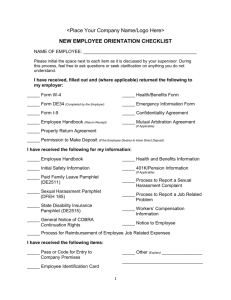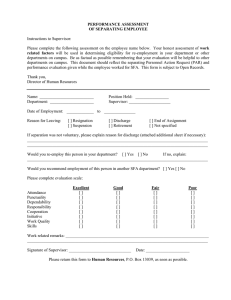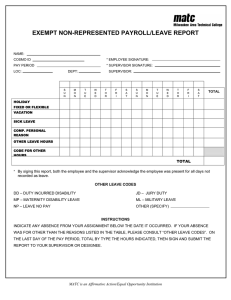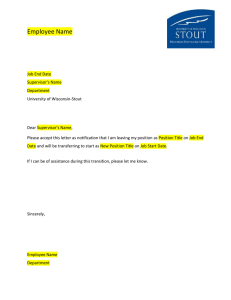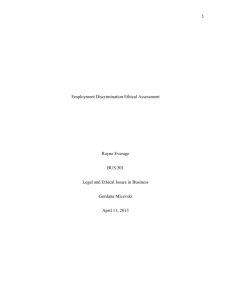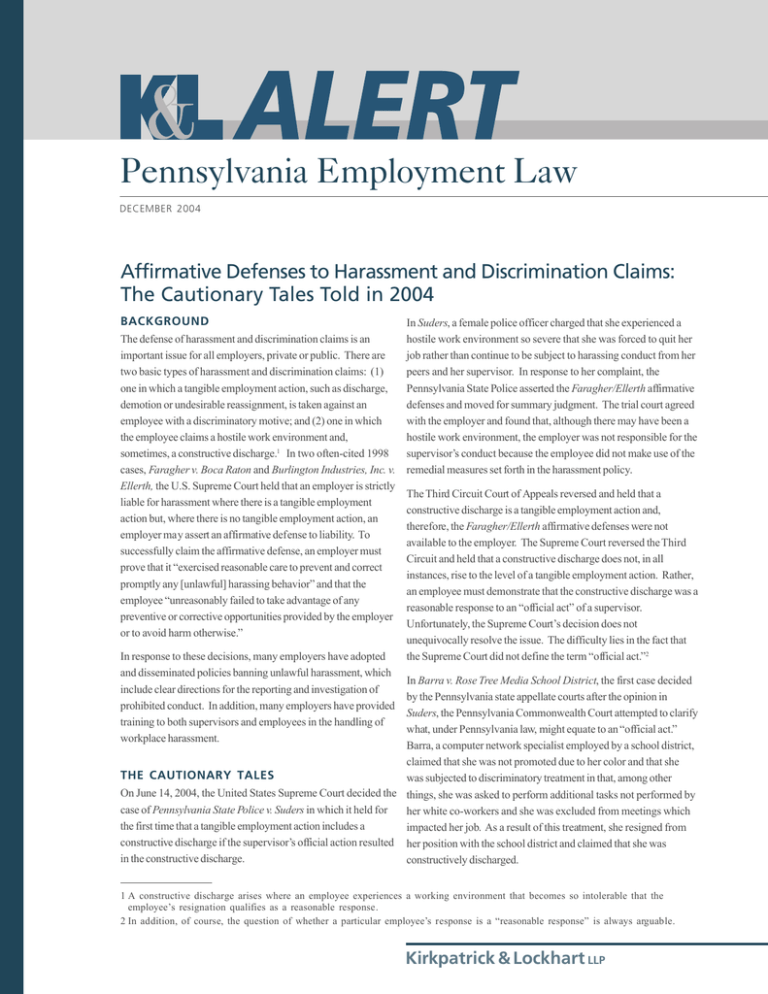
Pennsylvania Employment Law
DECEMBER 2004
Affirmative Defenses to Harassment and Discrimination Claims:
The Cautionary Tales Told in 2004
BACKGROUND
The defense of harassment and discrimination claims is an
important issue for all employers, private or public. There are
two basic types of harassment and discrimination claims: (1)
one in which a tangible employment action, such as discharge,
demotion or undesirable reassignment, is taken against an
employee with a discriminatory motive; and (2) one in which
the employee claims a hostile work environment and,
sometimes, a constructive discharge.1 In two often-cited 1998
cases, Faragher v. Boca Raton and Burlington Industries, Inc. v.
Ellerth, the U.S. Supreme Court held that an employer is strictly
liable for harassment where there is a tangible employment
action but, where there is no tangible employment action, an
employer may assert an affirmative defense to liability. To
successfully claim the affirmative defense, an employer must
prove that it “exercised reasonable care to prevent and correct
promptly any [unlawful] harassing behavior” and that the
employee “unreasonably failed to take advantage of any
preventive or corrective opportunities provided by the employer
or to avoid harm otherwise.”
In response to these decisions, many employers have adopted
and disseminated policies banning unlawful harassment, which
include clear directions for the reporting and investigation of
prohibited conduct. In addition, many employers have provided
training to both supervisors and employees in the handling of
workplace harassment.
In Suders, a female police officer charged that she experienced a
hostile work environment so severe that she was forced to quit her
job rather than continue to be subject to harassing conduct from her
peers and her supervisor. In response to her complaint, the
Pennsylvania State Police asserted the Faragher/Ellerth affirmative
defenses and moved for summary judgment. The trial court agreed
with the employer and found that, although there may have been a
hostile work environment, the employer was not responsible for the
supervisor’s conduct because the employee did not make use of the
remedial measures set forth in the harassment policy.
The Third Circuit Court of Appeals reversed and held that a
constructive discharge is a tangible employment action and,
therefore, the Faragher/Ellerth affirmative defenses were not
available to the employer. The Supreme Court reversed the Third
Circuit and held that a constructive discharge does not, in all
instances, rise to the level of a tangible employment action. Rather,
an employee must demonstrate that the constructive discharge was a
reasonable response to an “official act” of a supervisor.
Unfortunately, the Supreme Court’s decision does not
unequivocally resolve the issue. The difficulty lies in the fact that
the Supreme Court did not define the term “official act.”2
In Barra v. Rose Tree Media School District, the first case decided
by the Pennsylvania state appellate courts after the opinion in
Suders, the Pennsylvania Commonwealth Court attempted to clarify
what, under Pennsylvania law, might equate to an “official act.”
Barra, a computer network specialist employed by a school district,
claimed that she was not promoted due to her color and that she
THE CAUTIONARY TALES
was subjected to discriminatory treatment in that, among other
On June 14, 2004, the United States Supreme Court decided the things, she was asked to perform additional tasks not performed by
case of Pennsylvania State Police v. Suders in which it held for
her white co-workers and she was excluded from meetings which
the first time that a tangible employment action includes a
impacted her job. As a result of this treatment, she resigned from
constructive discharge if the supervisor’s official action resulted her position with the school district and claimed that she was
in the constructive discharge.
constructively discharged.
1 A constructive discharge arises where an employee experiences a working environment that becomes so intolerable that the
employee’s resignation qualifies as a reasonable response.
2 In addition, of course, the question of whether a particular employee’s response is a “reasonable response” is always arguable.
Kirkpatrick & Lockhart LLP
After the Pennsylvania Human Relations Commission and the
Equal Employment Opportunity Commission found that there was
no probable cause to support her claim, Barra filed a complaint in
the local county court. In response, the school district asserted the
Faragher/Ellerth affirmative defenses. The trial court entered
summary judgment in favor of the school district finding that, on
the facts presented, the school district was not responsible for the
actions of its employees. Barra appealed.
On appeal, Barra argued that her constructive discharge resulted
from official acts of her supervisor and, therefore, the school
district should be held strictly liable for the actions of its
employees. The Commonwealth Court disagreed and held that
she had not alleged an official act. According to the court, the
following actions taken against an employee by the supervisor do
not constitute “official acts” of a supervisor:
■
Assignment of a heavier workload than that assigned to other
similarly-situated employees;
■
A requirement that the employee maintain a daily log of work
and location;
■
The failure to include the employee in meetings with vendors;
■
The taking of office keys from the employee;
■
The failure to give a performance evaluation; and,
■
Critical, insulting emails from the employee’s supervisor.
Although the Pennsylvania Commonwealth Court found that
these actions were not “official acts” of the supervisor and,
FOR MORE INFORMATION, please contact one of the following
K&L lawyers:
Boston
Henry T. Goldman
617.951.9156 hgoldman@kl.com
Dallas
Jaime Ramón
214.939.4902 jramon@kl.com
Harrisburg Carleton O. Strouss 717.231.4503 cstrouss@kl.com
Los Angeles Thomas H. Petrides 310.552.5077 tpetrides@kl.com
Paul W. Sweeney, Jr. 310.552.5055 psweeney@kl.com
Miami
Carol C. Lumpkin
305.539.3323 clumpkin@kl.com
Michael C. Marsh
305.539.3321 mmarsh@kl.com
Newark
Rosemary Alito
973.848.4022 ralito@kl.com
Vincent N. Avallone 973.848.4027 vavallone@kl.com
Marilyn Sneirson
973.848.4028 msneirson@kl.com
NewYork
Eva Ciko
212.536.3905 eciko@kl.com
Pittsburgh
Stephen M. Olson 412.355.6496 solson@kl.com
Michael A. Pavlick 412.355.6275 mpavlick@kl.com
Hayes C. Stover
412.355.6476 hstover@kl.com
San Francisco Jonathan M. Cohen 415.249.1029 jcohen@kl.com
Washington Lawrence C. Lanpher 202.778.9011 llanpher@kl.com
therefore, the Faragher/Ellerth affirmative defenses were available
to the school district, the court also found that the school district
did not satisfy its burden of proving the affirmative defenses. The
court held that the school district’s unlawful harassment policy
was too narrow. The policy addressed only “hate-based conduct”
and failed to expressly address discrimination and discriminatory
conduct. According to the court, those omissions rendered the
policy fatally deficient.
CONCLUSION
These decisions are cautionary tales for employers, especially
those doing business in Pennsylvania. The U.S. Supreme Court’s
decision in Suders placed employers on notice that they may be
held liable for the constructive discharge of an employee if the
constructive discharge comes about because of an “official act” of
a supervisor. However, according to the Commonwealth Court’s
decision in Barra, an employee bears a high burden in
demonstrating that a supervisor’s conduct amounts to an “official
act.” It appears that, to allege an “official act,” an employee must
allege more than harassing conduct by the supervisor.
Further, the Commonwealth Court’s decision in Barra has told us
that an employer should examine its unlawful harassment policy
to ensure that it expressly addresses all types of discrimination and
harassment. Based upon the close scrutiny by the court of the
school district’s policy in Barra, a failure to include express
language that specifically identifies each type of harassment, i.e.,
gender, racial or national origin, and the types of conduct
prohibited, could result in the court finding that the employer
cannot avail itself of the affirmative defenses.
Finally, these decisions tell the cautionary tale that, until the term
“official act” is more clearly defined, it could be difficult for an
employer to obtain summary judgment on the basis of the
Faragher/Ellerth affirmative defenses.
JACQUELINE JACKSON-DEGARCIA
jjacksondegarcia@kl.com
717.231.5877
JOHN P. KRILL, JR.
jkrill@kl.com
717.231.4505
The attorneys resident in all offices, unless otherwise indicated,
are not certified by the Texas Board of Legal Specialization.
®
Kirkpatrick & Lockhart LLP
Challenge us. ®
www.kl.com
BOSTON
■
DALLAS
■
HARRISBURG
■
LOS ANGELES
■
MIAMI
■
NEWARK
■
NEW YORK
■
PITTSBURGH
■
SAN FRANCISCO
■
WASHINGTON
.................................................................................................................................................................
This publication/newsletter is for informational purposes and does not contain or convey legal advice. Please note that information about
prevailing law is limited to the particular state or federal jurisdiction(s) covered by the cited law and cases, and stricter
rules may apply in some states. This newsletter should not be relied upon in regard to any particular facts or
circumstances without first consulting a lawyer.
© 2004 KIRKPATRICK & LOCKHART LLP.
ALL RIGHTS RESERVED.

